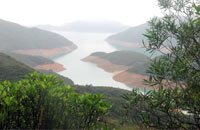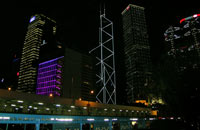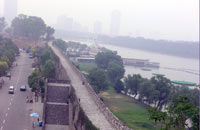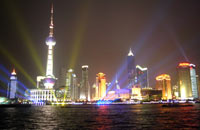| UAlbany student's China journal
Urban studies and planning Professor Chris Smith and history Professor Jennifer Rudolph accompanied students on a three week trip to China this summer. The students visited five cities, starting in Hong Kong, making stops at Shenzhen, Guangzhou, Nanjing, and ending in Shanghai. The program immersed students in Chinese culture where they directly experienced themes such as the impacts of globalization, migration from rural to urban areas, the emergence of private housing, the increasing prevalence of social and health problems, as well as contact with many aspects of China's historical development.
May 27 - Today we took a bus to the Hong Kong Museum of History where the professors asked us to take notes on any parts of the museum that focused on how the British gained control of Hong Kong, the model they used to govern it, and the conditions in which China came under control of Hong Kong in 1997.
May 28 - Today we went on a boat trip around the New Territories with Dr. Bernie Owen from the Hong Kong Baptist geography department. We set out from the northeast
of Kowloon and took the boat out into the South China Sea stopping at a couple of different islands. From one of the islands you could see the main seaport of China where
all of our "Made in China" goods come from. May 29 - Today was our first day of lectures. The first was by Dr. Timothy Wong, a history professor at HKBU, on the history of Hong Kong from 1840 to the present. This topic relates to my major and may be the basis of the paper I will write. Later we took a bus trip and saw some multi-story factories and some public housing on the Kowloon side of Hong Kong. On the way up to Victoria's Peak, the high point of Hong Kong, we stopped to look at some more public and private housing. The most interesting feature I saw was that in a lot of the buildings there was a hole cut out in the middle of the building. Apparently this is for Feng Shui, so that the chi or energy can flow through the building without being stopped. May 30 - Today Professor Rudolph lectured about the general history of China. This was good because it filled in a lot of "gaps" for me, put identities to people's names that I had heard but knew nothing about. I had never studied any Chinese history outside the very broad chapter in world history.
June 1 - Today was the first day of the Academic Conference at HKBU. "Changing Geography in a Diversified World". This was my first time attending an academic conference so it was a good experience. The keynote speaker was Dr. Swyngedouw. He talked about how cities try to throw themselves onto the global level with one massive building project. They become landmarks that make it a globally recognized city. Today was the first time I've heard the term "urban competitiveness." It is a very popular theme within China. June 2 - Today's lecture was about the active and passive processes by which suburbanization is initiated and also about decentralization of industry, population renewal and especially about private communities. One of the main themes at the conference is "Glocalization" or the coming together of local and national and global regions. June 4 -We checked out of the NTT International house in Hong Kong and left on a bus for Shenzhen. We picked up Michael Gallagher, our tour guide for the day. He is an urban planner working in the Urban Planning offices in Shenzhen. He was giving us information that related to his field, but on top of that he was giving us a really good sense of the city outside of just urban planning. Things like consumerism, some social aspects, and of course some information about the night life.
June 6 - We took another trip to downtown Guangzhou to visit an NGO called the Center for Contemporary Observation. This organization fights for workers' rights and helps workers where they can. NGO's are illegal in China. It was incredibly interesting what these people were doing, especially in a country where what they are doing is illegal, and that the government could just come in and shut down the whole operation at any time. Later we flew to Nanjing and checked into the South Campus Hotel at the Nanjing University. June 8 - Today we had "a tour of republican Nanjing" and went to the Nanjing massacre museum. This place really drove the point home of how brutal and obscene this event was. It brought a few people to tears. They had different plaques for areas and events within the city that contributed to the total number of deaths. This was the highlight of Nanjing. June 9 - I went with Prof. Rudolph's group to visit an actual Confucian Temple. The temple had a newly constructed statue of Confucius; the original was probably destroyed during the Cultural Revolution. On either side of the entrance where the statue was there were some really nice markets, some people bought little red book with Mao's quotes. In one of Prof Rudolph's lectures she talked about how people would respond to questions using these quotes. For example if someone said: "how are you?" the other person might respond with one of Mao's quotes: "I'm basking in the glory of China."
June 11 - First day in Shanghai. After the lectures we went to the Yuan Yuan Gardens and from there we went to the Bund which is an area along the Wusong River that runs through the heart of the city. This is the most International area of Shanghai. The number one attraction of The Bund is that it looks out onto the Pudong side (opposite side of the Wusong) which is where the financial district is located. June 12 - Today we had discussions in the morning about our paper topics and a final opinion session about the trip as a whole. We went to the Propaganda Gallery and after that we went to the Urban Planning museum in Renmin Square. There was a giant floor model of Shanghai and we got to see some models of buildings they are planning--including what would be the tallest building in Asia with a giant hole for Feng Shui in it. June 13 - Home! |
||||||||||||||||||||
|
Related Links: |
||||||||||||||||||||
Recent Features: |
||||||||||||||||||||
|
||||||||||||||||||||
|
||||||||||||










